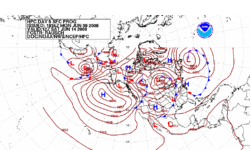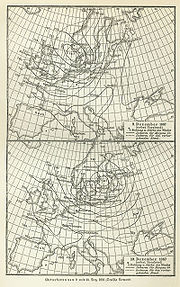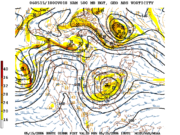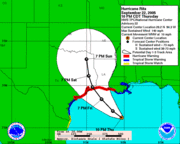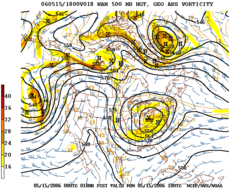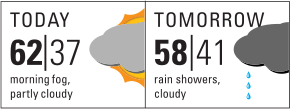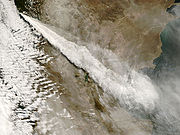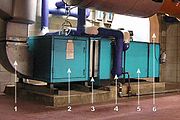
Weather forecasting
About this schools Wikipedia selection
This content from Wikipedia has been selected by SOS Children for suitability in schools around the world. SOS Children is the world's largest charity giving orphaned and abandoned children the chance of family life.
Weather forecasting is the application of science and technology to predict the state of the atmosphere for a future time and a given location. Human beings have attempted to predict the weather informally for millennia, and formally since at least the nineteenth century. Weather forecasts are made by collecting quantitative data about the current state of the atmosphere and using scientific understanding of atmospheric processes to project how the atmosphere will evolve.
Once an all-human endeavor based mainly upon changes in barometric pressure, current weather conditions, and sky condition, forecast models are now used to determine future conditions. Human input is still required to pick the best possible forecast model to base the forecast upon, which involves pattern recognition skills, teleconnections, knowledge of model performance, and knowledge of model biases. The chaotic nature of the atmosphere, the massive computational power required to solve the equations that describe the atmosphere, error involved in measuring the initial conditions, and an incomplete understanding of atmospheric processes mean that forecasts become less accurate as the difference in current time and the time for which the forecast is being made (the range of the forecast) increases. The use of ensembles and model consensus help narrow the error and pick the most likely outcome.
There are a variety of end uses to weather forecasts. Weather warnings are important forecasts because they are used to protect life and property. Forecasts based on temperature and precipitation are important to agriculture, and therefore to traders within commodity markets. Temperature forecasts are used by utility companies to estimate demand over coming days. On an everyday basis, people use weather forecasts to determine what to wear on a given day. Since outdoor activities are severely curtailed by heavy rain, snow and the wind chill, forecasts can be used to plan activities around these events, and to plan ahead and survive them.
History
For millennia people have tried to forecast the weather. In 650 BC, the Babylonians predicted the weather from cloud patterns as well as astrology. In about 340 BC, Aristotle described weather patterns in Meteorologica. Later, Theophrastus compiled a book on weather forecasting, called the Book of Signs. Chinese weather prediction lore extends at least as far back as 300 BC, which was also around the same time ancient Indian astronomers developed weather-prediction methods. In 904 AD, Ibn Wahshiyya's Nabatean Agriculture discussed the weather forecasting of atmospheric changes and signs from the planetary astral alterations; signs of rain based on observation of the lunar phases; and weather forecasts based on the movement of winds.
Ancient weather forecasting methods usually relied on observed patterns of events, also termed pattern recognition. For example, it might be observed that if the sunset was particularly red, the following day often brought fair weather. This experience accumulated over the generations to produce weather lore. However, not all of these predictions prove reliable, and many of them have since been found not to stand up to rigorous statistical testing.
It was not until the invention of the electric telegraph in 1835 that the modern age of weather forecasting began. Before this time, it was not widely practicable to transport information about the current state of the weather any faster than a steam train (and the train also was a very new technology at that time). By the late 1840s, the telegraph allowed reports of weather conditions from a wide area to be received almost instantaneously, allowing forecasts to be made from knowledge of weather conditions further upwind. The two men most credited with the birth of forecasting as a science were Francis Beaufort (remembered chiefly for the Beaufort scale) and his protégé Robert Fitzroy (developer of the Fitzroy barometer). Both were influential men in British naval and governmental circles, and though ridiculed in the press at the time, their work gained scientific credence, was accepted by the Royal Navy, and formed the basis for all of today's weather forecasting knowledge. To convey information accurately, it became necessary to have a standard vocabulary describing clouds; this was achieved by means of a series of classifications and, in the 1890s, by pictorial cloud atlases.
Great progress was made in the science of meteorology during the 20th century. The possibility of numerical weather prediction was proposed by Lewis Fry Richardson in 1922, though computers did not exist to complete the vast number of calculations required to produce a forecast before the event had occurred. Practical use of numerical weather prediction began in 1955, spurred by the development of programmable electronic computers.
In the United States, the first public radio forecasts were made in 1925 by Edward B. "E.B." Rideout, on WEEI, the Edison Electric Illuminating station in Boston. Rideout came from the U.S. Weather Bureau, as did WBZ weather forecaster G. Harold Noyes in 1931. Television forecasts followed with Jimmie Fidler in Cincinnati in 1940 or 1947 on the DuMont Television Network. The Weather Channel is a 24-hour cable network that began broadcasting in May 1982.
How models create forecasts
The basic idea of numerical weather prediction is to sample the state of the fluid at a given time and use the equations of fluid dynamics and thermodynamics to estimate the state of the fluid at some time in the future. The main inputs from country-based weather services are surface observations from automated weather stations at ground level over land and from weather buoys at sea. The World Meteorological Organization acts to standardize the instrumentation, observing practices and timing of these observations worldwide. Stations either report hourly in METAR reports, or every six hours in SYNOP reports. Sites launch radiosondes, which rise through the depth of the troposphere and well into the stratosphere. Data from weather satellites are used in areas of where traditional data sources are not available. Compared with similar data from radiosondes, the satellite data has the advantage of global coverage, however at a lower accuracy and resolution. Meteorological radar provide information on precipitation location and intensity, which can be used to estimate precipitation accumulations over time. Additionally, if a Pulse Doppler weather radar is used then wind speed and direction can be determined.
Commerce provides pilot reports along aircraft routes, and ship reports along their shipping routes. Research flights using reconnaissance aircraft fly in and around weather systems of interest such as tropical cyclones. Reconnaissance aircraft are also flown over the open oceans during the cold season into systems which cause significant uncertainty in forecast guidance, or are expected to be of high impact 3–7 days into the future over the downstream continent.
Models are initialized using this observed data. The irregularly spaced observations are processed by data assimilation and objective analysis methods, which perform quality control and obtain values at locations usable by the model's mathematical algorithms (usually an evenly spaced grid). The data are then used in the model as the starting point for a forecast.Commonly, the set of equations used to predict the known as the physics and dynamics of the atmosphere are called primitive equations. These equations are initialized from the analysis data and rates of change are determined. The rates of change predict the state of the atmosphere a short time into the future. The equations are then applied to this new atmospheric state to find new rates of change, and these new rates of change predict the atmosphere at a yet further time into the future. This time stepping procedure is continually repeated until the solution reaches the desired forecast time. The length of the time step is related to the distance between the points on the computational grid. Time steps for global climate models may be on the order of tens of minutes, while time steps for regional models may be a few seconds to a few minutes.
The equations used to compute the forecast are nonlinear partial differential equations which are impossible to solve exactly. Therefore, numerical methods obtain approximate solutions. Different models use different solution methods. Some global models use spectral methods for the horizontal dimensions and finite difference methods for the vertical dimension, while regional models and other global models usually use finite-difference methods in all three dimensions. The visual output produced by a model solution is known as a prognostic chart, or prog for short. The raw output is often modified before being presented as the forecast. This can be in the form of statistical techniques to remove known biases in the model, or of adjustment to take into account consensus among other numerical weather forecasts. MOS or model output statistics is a technique used to interpret numerical model output and produce site-specific guidance. This guidance is presented in coded numerical form, and can be obtained for nearly all National Weather Service reporting stations in the United States.
As proposed by Edward Lorenz in 1963, long range forecasts, those made at a range of two weeks or more, are impossible to definitively predict the state of the atmosphere, owing to the chaotic nature of the fluid dynamics equations involved. Extremely small errors in the initial input, such as temperatures and winds, within numerical models doubles every five days.
Techniques
Persistence
The simplest method of forecasting the weather, persistence, relies upon today's conditions to forecast the conditions tomorrow. This can be a valid way of forecasting the weather when it is steady state, such as during the summer season in the tropics. This method of forecasting strongly depends upon the presence of a stagnant weather pattern. It can be useful in both short range forecasts and long range forecasts.
Use of a barometer
Using barometric pressure and the pressure tendency (the change of pressure over time) has been used in forecasting since the late 19th century. The larger the change in pressure, especially if more than 3.5 hPa (0.10 inHg), the larger the change in weather can be expected. If the pressure drop is rapid, a low pressure system is approaching, and there is a greater chance of rain . Rapid pressure rises are associated with improving weather conditions, such as clearing skies.
Looking at the sky
Along with pressure tendency, use of the sky condition is one of more important weather parameters that can be used to forecast weather in mountainous areas. Thickening of cloud cover or the invasion of a higher cloud deck is indicative of rain in the near future. Morning fog portends fair conditions, as rainy conditions are preceded by wind or clouds which prevent fog formation. The approach of a line of thunderstorms could indicate the approach of a cold front. Cloud-free skies are indicative of fair weather for the near future. A bar can indicate a coming tropical cyclone. The use of sky cover in weather prediction has led to various weather lore over the centuries.
Nowcasting
The term nowcasting is also used in economics.
The forecasting of the weather within the next six hours is often referred to as nowcasting. In this time range it is possible to forecast smaller features such as individual showers and thunderstorms with reasonable accuracy, as well as other features too small to be resolved by a computer model. A human given the latest radar, satellite and observational data will be able to make a better analysis of the small scale features present and so will be able to make a more accurate forecast for the following few hours.
Use of forecast models
In the past, the human forecaster was responsible for generating the entire weather forecast based upon available observations. Today, human input is generally confined to choosing a model based on various parameters, such as model biases and performance. Using a consensus of forecast models, as well as ensemble members of the various models, can help reduce forecast error. However, regardless how small the average error becomes with any individual system, large errors within any particular piece of guidance are still possible on any given model run. Humans are required to interpret the model data into weather forecasts that are understandable to the end user. Humans can use knowledge of local effects which may be too small in size to be resolved by the model to add information to the forecast. While increasing accuracy of forecast models implies that humans may no longer be needed in the forecast process at some point in the future, there is currently still a need for human intervention.
Analog technique
The Analog technique is a complex way of making a forecast, requiring the forecaster to remember a previous weather event which is expected to be mimicked by an upcoming event. What makes it a difficult technique to use is that there is rarely a perfect analog for an event in the future. Some call this type of forecasting pattern recognition. It remains a useful method of observing rainfall over data voids such as oceans, as well as the forecasting of precipitation amounts and distribution in the future. A similar technique is used in medium range forecasting, which is known as teleconnections, when systems in other locations are used to help pin down the location of another system within the surrounding regime. An example of teleconnections are by using El Niño-Southern Oscillation (ENSO) related phenomena.
- Analog model – A model based on similarities between the system under study and another system or process.
- Analytical model – A model that uses classic methods such as calculus or algebra to solve a series of equations.
- Conceptual model – A simplified representation of the system being examined.
- Continuous model – A model that uses continuous simulation, as opposed to a single-event model.
- Deterministic model – A model that produces the same output for a given input without consideration for risk or uncertainty.
- Empirical model – A model represented by simplified processes based on observation, measurements, or practical experience rather than solely on principles or theory. A lumped model is an example.
- Explicit model – A numerical model that uses parameter values or unknown variables at the beginning of a time step in the computational algorithms.
- Implicit model – A numerical model that uses parameter values or unknown variables at the end of a time step in the computational algorithms.
- Mass balance model – A model based on the conservation of mass and focuses on balancing inputs and outputs from the model area. Also known as a zero-dimensional model.
- Numerical model – A model that uses a numerical method to solve a series of equations, as opposed to an analytical model. The results from numerical models are often approximations, while analytic models produce exact solutions.
- One-dimensional model – A model that includes only one space dimension.
- Pseudo-deterministic model – A semi-distributed model.
- Stochastic mathematical model – A model that includes statistical elements and produces a set of outputs for a given set of inputs. The output represents a set of expected values.
- Two-dimensional model – A model that includes two space dimensions, usually horizontal and vertical averaging.
Most end users of forecasts are members of the general public. Thunderstorms can create strong winds and dangerous lightning strikes that can lead to deaths, power outages, and widespread hail damage. Heavy snow or rain can bring transportation and commerce to a stand-still, as well as cause flooding in low-lying areas. Excessive heat or cold waves can sicken or kill those with inadequate utilities, and droughts can impact water usage and destroy vegetation.
Several countries employ government agencies to provide forecasts and watches/warnings/advisories to the public in order to protect life and property and maintain commercial interests. Knowledge of what the end user needs from a weather forecast must be taken into account to present the information in a useful and understandable way. Examples include the National Oceanic and Atmospheric Administration's National Weather Service (NWS) and Environment Canada's Meteorological Service (MSC). Traditionally, newspaper, television, and radio have been the primary outlets for presenting weather forecast information to the public. Increasingly, the internet is being used due to the vast amount of specific information that can be found. In all cases, these outlets update their forecasts on a regular basis.
Severe weather alerts and advisories
A major part of modern weather forecasting is the severe weather alerts and advisories which the national weather services issue in the case that severe or hazardous weather is expected. This is done to protect life and property. Some of the most commonly known of severe weather advisories are the severe thunderstorm and tornado warning, as well as the severe thunderstorm and tornado watch. Other forms of these advisories include winter weather, high wind, flood, tropical cyclone, and fog. Severe weather advisories and alerts are broadcast through the media, including radio, using emergency systems as the Emergency Alert System which break into regular programming.
Air traffic
Because the aviation industry is especially sensitive to the weather, accurate weather forecasting is essential. Fog or exceptionally low ceilings can prevent many aircraft from landing and taking off. Turbulence and icing are also significant in-flight hazards. Thunderstorms are a problem for all aircraft because of severe turbulence due to their updrafts and outflow boundaries, icing due to the heavy precipitation, as well as large hail, strong winds, and lightning, all of which can cause severe damage to an aircraft in flight. Volcanic ash is also a significant problem for aviation, as aircraft can lose engine power within ash clouds. On a day to day basis airliners are routed to take advantage of the jet stream tailwind to improve fuel efficiency. Aircrews are briefed prior to takeoff on the conditions to expect en route and at their destination. Additionally, airports often change which runway is being used to take advantage of a headwind. This reduces the distance required for takeoff, and eliminates potential crosswinds.
Marine
Commercial and recreational use of waterways can be limited significantly by wind direction and speed, wave periodicity and heights, tides, and precipitation. These factors can each influence the safety of marine transit. Consequently, a variety of codes have been established to efficiently transmit detailed marine weather forecasts to vessel pilots via radio, for example the MAFOR (marine forecast). Typical weather forecasts can be received at sea through the use of RTTY, Navtex and Radiofax.
Agriculture
Farmers rely on weather forecasts to decide what work to do on any particular day. For example, drying hay is only feasible in dry weather. Prolonged periods of dryness can ruin cotton, wheat, and corn crops. While corn crops can be ruined by drought, their dried remains can be used as a cattle feed substitute in the form of silage. Frosts and freezes play havoc with crops both during the spring and fall. For example, peach trees in full bloom can have their potential peach crop decimated by a spring freeze. Orange groves can suffer significant damage during frosts and freezes, regardless of their timing.
Forestry
Weather forecasting of wind, precipitations and humidity is essential for preventing and controlling wildfires. Different indices, like the Forest fire weather index and the Haines Index, have been developed to predict the areas more at risk to experience fire from natural or human causes. Conditions for the development of harmful insects can be predicted by forecasting the evolution of weather, too.
Utility companies
Electricity and gas companies rely on weather forecasts to anticipate demand which can be strongly affected by the weather. They use the quantity termed the degree day to determine how strong of a use there will be for heating ( heating degree day) or cooling (cooling degree day). These quantities are based on a daily average temperature of 65 °F (18 °C). Cooler temperatures force heating degree days (one per degree Fahrenheit), while warmer temperatures force cooling degree days. In winter, severe cold weather can cause a surge in demand as people turn up their heating. Similarly, in summer a surge in demand can be linked with the increased use of air conditioning systems in hot weather. By anticipating a surge in demand, utility companies can purchase additional supplies of power or natural gas before the price increases, or in some circumstances, supplies are restricted through the use of brownouts and blackouts.
Private sector
Increasingly, private companies pay for weather forecasts tailored to their needs so that they can increase their profits or avoid large losses. For example, supermarket chains may change the stocks on their shelves in anticipation of different consumer spending habits in different weather conditions. Weather forecasts can be used to invest in the commodity market, such as futures in oranges, corn, soybeans, and oil.
Military applications
United States Armed Forces
Similarly to the private sector, military weather forecasters present weather conditions to the war fighter community. Military weather forecasters provide pre-flight and in-flight weather briefs to pilots and provide real time resource protection services for military installations. Naval forecasters cover the waters and ship weather forecasts. The United States Navy provides a special service to both themselves and the rest of the federal government by issuing forecasts for tropical cyclone across the Pacific and Indian Oceans through their Joint Typhoon Warning Centre.
US Air Force
Within the United States, Air Force Weather provides weather forecasting for the Air Force and the Army. Air Force forecasters cover air operations in both wartime and peacetime operations and provide Army support; United States Coast Guard marine science technicians provide ship forecasts for ice breakers and other various operations within their realm; and Marine forecasters provide support for ground- and air-based United States Marine Corps operations. All four military branches take their initial enlisted meteorology technical training at Keesler Air Force Base. Military and civilian forecasters actively cooperate in analyzing, creating and critiquing weather forecast products.
